Configure JAS with a User Registry - LDAP or File Based
Authors: ShubjitNaikBuild basis: JAS and ELM version 6.0.x, 7.x
Jazz Authorization Server is based on the IBM WebSphere Liberty server. Because Jazz Authorization Server authenticates users, it must be configured with a user registry. WebSphere Liberty server has capabilities similar to the full WebSphere Application Server; it can be configured to use a Lightweight Directory Access Protocol (LDAP) registry, or users can be defined in local files.
This article will focus on steps to help configure JAS with a File based User Registry and LDAP User registry.
JTS > Advanced Properties > com.ibm.team.repository.service.jts.internal.userregistry.ldap.LDAPUserRegistryProvider for User group to Jazz role mappings.
Here is an extract from JTS logs with debug enabled, where it is mapping to the Jazz Groups configured in JTS.
Installation
ELM- To deploy JAS to an existing environment and migrate to JAS, visit this Section on our Infocenter
- For a new deployment of ELM, Install the applications via IBM Installation Manager and Select the option "Enable Jazz Security Architecture SSO" during the installation

- Download Jazz Authorization Server install bit from jazz.net, under All Downloads Section for the specific version

- Install Jazz Authorization Server application via Installation Manager, instructions available on our Infocenter
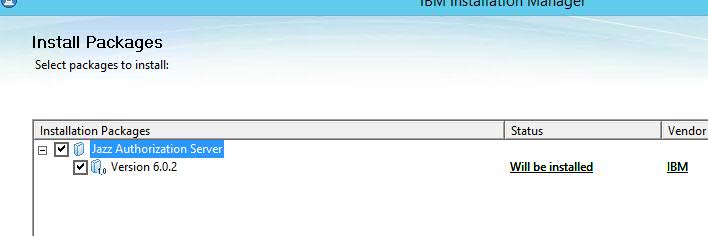
Setup and Configure JAS with a User Registry
Configuration files
- Copy the files from
JazzAuthServer_install_dir/wlp/usr/servers/jazzop/defaultsfolder one level up toJazzAuthServer_install_dir/wlp/usr/servers/jazzop/ - Files we would modify are
server.xml,appConfig.xml,ldapUserRegistry.xmlandlocalUserRegistry.xml -
appConfig.xml- Contains Jazz Group/Role mappings and UserRegistry file information -
ldapUserRegistry.xml- Configuring Liberty with an LDAP user registry -
localUserRegistry.xml- Configuring Liberty file based registry
To Configure JAS with LDAP registry
- By default the bundled Liberty profile is configured with file based user registry
- To change the configuration to LDAP registry, edit
JazzAuthServer_install_dir/wlp/usr/servers/jazzop/appConfig.xmlfile - Towards the end of the file change from
-
<include location="localUserRegistry.xml" optional="true"/> <!--include location="ldapUserRegistry.xml" optional="true"/-->TO -
<!--include location="localUserRegistry.xml" optional="true"/--> <include location="ldapUserRegistry.xml" optional="true"/>
- To Configure the LDAP User Registry, guidance from LDAP administrators / Network admins may be necessary to complete the configuration Typical information needed from your LDAP Admin
- LDAP Server Name and Port (LDAP Server hostname and Port)
- The Base DN (LDAP Root Tree where Users/Groups can be queried from_)
- bindDN and bindPassword (User ID and password for the user who can query the LDAP directory)
- Group and User filter (inetOrgPerson, groupOfNames etc)
- User ID and Group ID mappings (sAMAccountName, cn etc)
- Example configuration for different LDAPs information is available in our Infocenter
- We have included a few examples from different LDAP environments (MS Active Directory, Tivoli and ApacheDS) to help guide the configuration.
- Edit
JazzAuthServer_install_dir/wlp/usr/servers/jazzop/ldapUserRegistry.xmland modify the ldapRegistry configuration for your LDAP registry
Microsoft Active Directory
-
<server> <ldapRegistry ldapType="Microsoft Active Directory" baseDN="CN=Users,DC=test,DC=com" bindDN="CN=CLM Admin,CN=Users,DC=test,DC=com" bindPassword="********" host="ldapserver" id="ldapserver:389" ignoreCase="true" port="389" realm="ldapserver:389" recursiveSearch="true" sslEnabled="false"> <activedFilters userFilter="(&(sAMAccountName=%v)(objectcategory=user))" groupFilter="(&(cn=%v)(objectcategory=group))" userIdMap="user:sAMAccountName" groupIdMap="*:cn" groupMemberIdMap="memberOf:member" > </activedFilters> </ldapRegistry> </server>
IBM Tivoli Directory Server
-
<server> <ldapRegistry ldapType="IBM Tivoli Directory Server" baseDN="o=test.com" bindDN="uid=clmadmin,c=in,ou=Users,o=test.com" bindPassword="********" host="ldapserver" id="ldapserver:389" ignoreCase="true" port="389" realm="ldapserver:389" recursiveSearch="true" sslEnabled="false"> <idsFilters groupFilter="(&(cn=%v)(|(objectclass=groupOfUniqueNames)(objectclass=posixGroup)))" groupIdMap="*:cn" groupMemberIdMap="groupOfUniqueNames:uniquemember" userFilter="(&(uid=%v)(objectclass=person))" userIdMap="*:uid"> </idsFilters> </ldapRegistry> </server>
Apache DS
-
<server> <ldapRegistry ldapType="Custom" baseDN="dc=example,dc=com" host="localhost" id="localhostexample:10389" ignoreCase="true" port="10389" realm="localhostexample:10389" recursiveSearch="true" sslEnabled="false"> <customFilters groupFilter="(&(cn=%v)(|(objectclass=groupOfUniqueNames)(objectclass=posixGroup)))" groupIdMap="*:cn" groupMemberIdMap="groupOfUniqueNames:uniquemember" userFilter="(&(uid=%v)(objectclass=inetOrgPerson))" userIdMap="*:uid" > </customFilters> </ldapRegistry> </server>
To Configure JAS with Liberty file based registry
- By default the bundled Liberty profile is configure with File based user registry.
- Open the file
JazzAuthServer_install_dir/wlp/usr/servers/jazzop/localUserRegistry.xml - Add new Users or Groups and save the file
- File based user registry should not be used for production environments.
- No password management functionality
- No password policy enforcement
- No direct user ability to change passwords.
<server>
<!-- Sample basic user registry definition
The passwords for the "ADMIN" and "clmadmin" users are the same as the user names.
If those users are to be retained, the wlp/bin/securityUtility script should be used
to encode new passwords. Otherwise, new users should defined with encoded passwords.
-->
<basicRegistry>
<user name="ADMIN" password="{xor}HhsSFhE="/>
<user name="clmadmin" password="{xor}PDMyPjsyNjE="/>
<user name="clmuser" password="plaintext_password"/>
<group id="JazzAdmins" name="JazzAdmins">
<member name="ADMIN"/>
<member name="clmadmin"/>
</group>
<group id="JazzUsers" name="JazzUsers">
<member name="clmuser"/>
</group>
<group id="JazzGuests" name="JazzGuests">
</group>
<group id="JazzProjectAdmins" name="JazzProjectAdmins">
</group>
</basicRegistry>
<administrator-role>
<user>clmadmin</user>
</administrator-role>
</server>
- You can either enter Plain Text Passwords or encrypt the passwords using the securityUtility
Map Administrators for Jazz Authorization Server
Map Groups or Users as JAS Administrators who can perform JAS CLI operations, register Applications to JAS and access WebSphere Liberty AdminConsole JAS<oauth-roles>
<authenticated>
<special-subject type="ALL_AUTHENTICATED_USERS" />
</authenticated>
<clientManager>
<group name="MYJazzAdmins" />
<group name="JazzAdmins"/>
<user name = "clmadmin" />
</clientManager>
</oauth-roles>
Encrypt Passwords
- To encrypt passwords, run the script
JazzAuthServer_install_dir/wlp/bin/securityUtility - After the script completes, copy the output to the password attribute associated with the user ID (or bindPassword)
- To run the securityUtility script, use the following syntax:
-
$ securityUtility encode userPassword
where userPassword is the password to encode
Configure Database for JAS
When you first install JAS, it comes configured to use a local Derby database for storing information. It is not recommended to use Derby database for a production environment and note that Derby database won't work in a clustered JAS environment, since that information won't be available to all the instances. The basic steps to configure the database are:- Create database tables on a database server which all JAS instances can access
- Update the JAS configuration file (appConfig.xml) to use the database server
JazzAuthServer_install_dir/wlp/usr/servers/jazzop/appConfig.xml file. The default configuration is
<oauthProvider id="JazzOP" httpsRequired="true" autoAuthorize="true" customLoginURL="/jazzop/form/login" accessTokenLifetime="7201" authorizationGrantLifetime="604801"> <autoAuthorizeClient>client01</autoAuthorizeClient> <databaseStore dataSourceRef="OAuthFvtDataSource" /> </oauthProvider>The value "604801" is 7 days plus 1 second, in seconds. It can be reduced to make refresh tokens expire quicker and therefore not accumulate as much in the database. For more information, see work item 471597
JVM
The default JVM heap allocated to a WebSphere Liberty server is 60MB. This applies to JAS as well and to increase the Java heap size, you can create jvm.options file underJazzAuthServer_install_dir/wlp/usr/servers/jazzop/jvm.options and include the JVM memory parameters, one per line. For example, these entries will increase the heap size to 2GB:
-Xms2G -Xmx2GFor more information see Manually Customizing Liberty Environment
Test JAS Configuration
- Now that JAS is configured with a User registry, it is time to start the server and test the configuration
- Start the server (Linux example)
$ cd JazzAuthServer_install_dir $ ./start-jazz - Access the following URLs to test JAS
- JAS Configuration URL
https://fully_qualified_domain_name_of_JAS_server:defined_port/oidc/endpoint/jazzop/.well-known/openid-configuration
and https://fully_qualified_domain_name_of_JAS_server:defined_port/oidc/endpoint/jazzop/registration default value for the registration URL is{"data":[]}
- JAS Configuration URL
Jazz Team Server (JTS) Setup with JAS
- For a new deployment, CLM installation should be enabled for Jazz Security Architecture SSO
- Accessing the JTS setup page, https://jtsserver:port/jts/setup , would not prompt for a Username / Password
- Express setup would be disabled for a CLM instance enabled for Jazz Security Architecture SSO

- Run through the setup following the prompt until you reach "Register Applications" Page
- Enter the Jazz Authentication Server details. The URL you enter should be accessible by all and is as important as the Jazz Public URI

File based registry
- In the Next step (Step 6), "Select a type of User Registry, select Non-LDAP External Registry
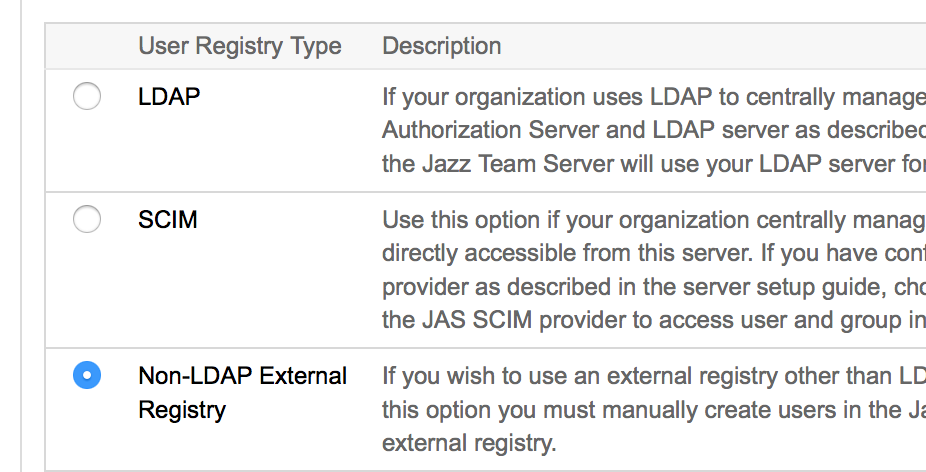
- Create a user with userID details from users configured in localUserRegistry.xml
- Click on Save and Log in and Login as a User with JazzAdmin role
- Assign a License to the User
- Go back to Register Applications page (Step 5) and register all the applications
- Complete the setup
LDAP Registry
User to Role Mappings- Groups to Jazz Roles mappings are picked from JTS configuration when JAS is configured with LDAP or SCIM. More details on the next section.
- In the Next step (Step 6), "Select a type of User Registry, select LDAP
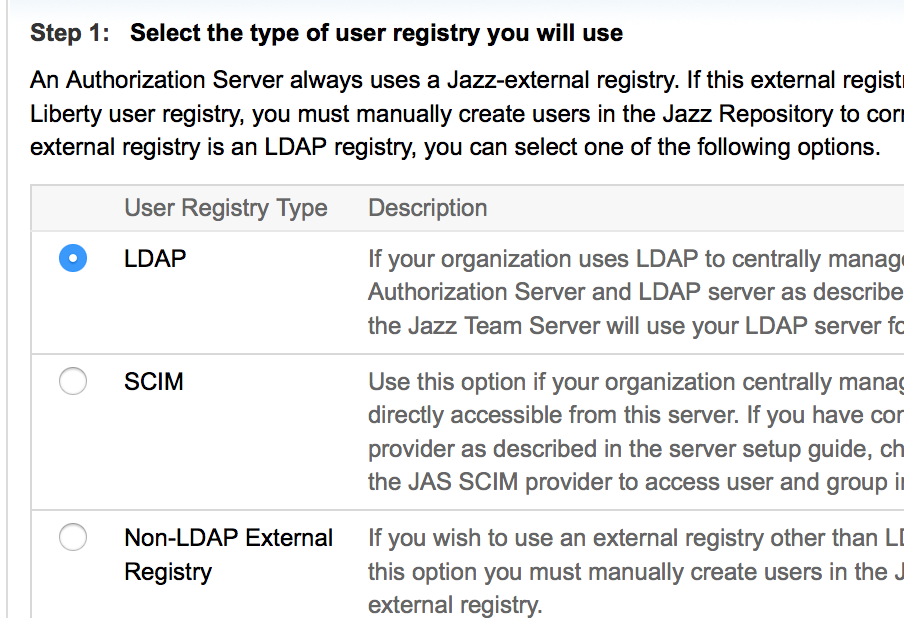
- Enter the LDAP Details, there are 3 sections as mentioned below
- - LDAP Server and Bind User details
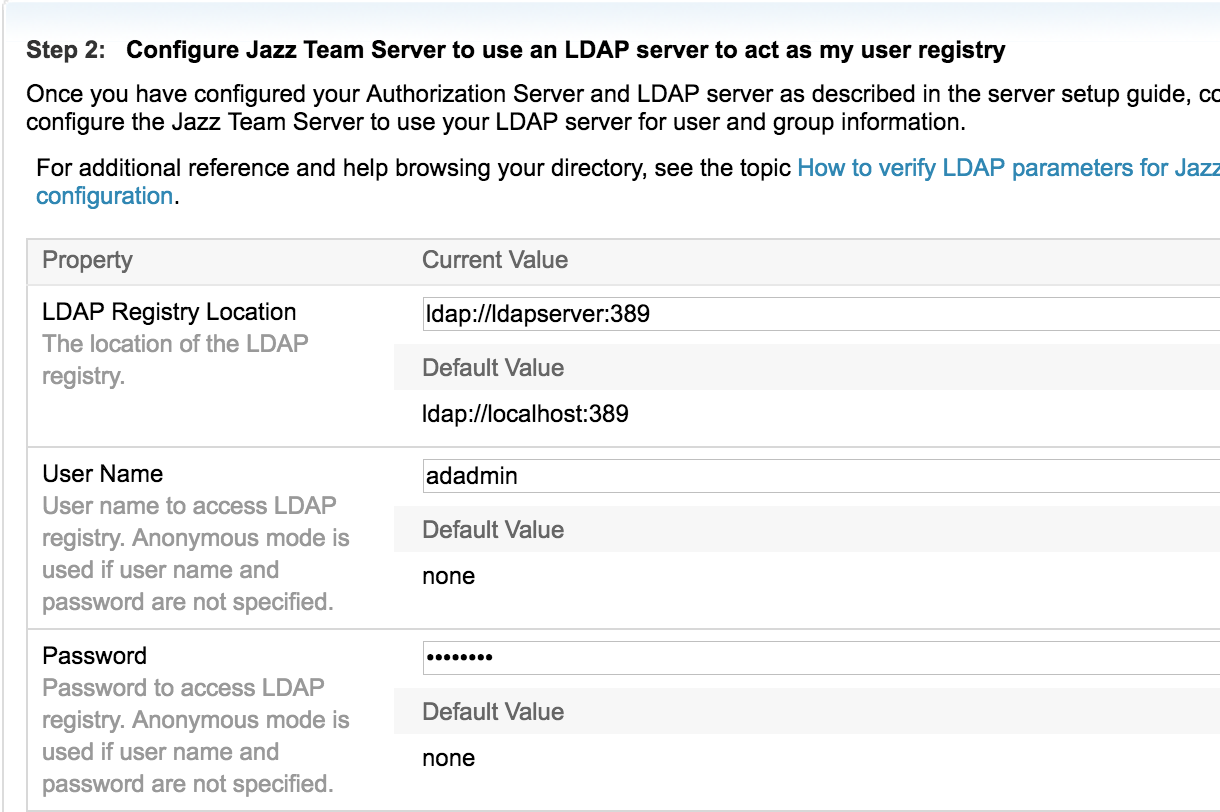
- - Base USer DN and USer Properties mapping
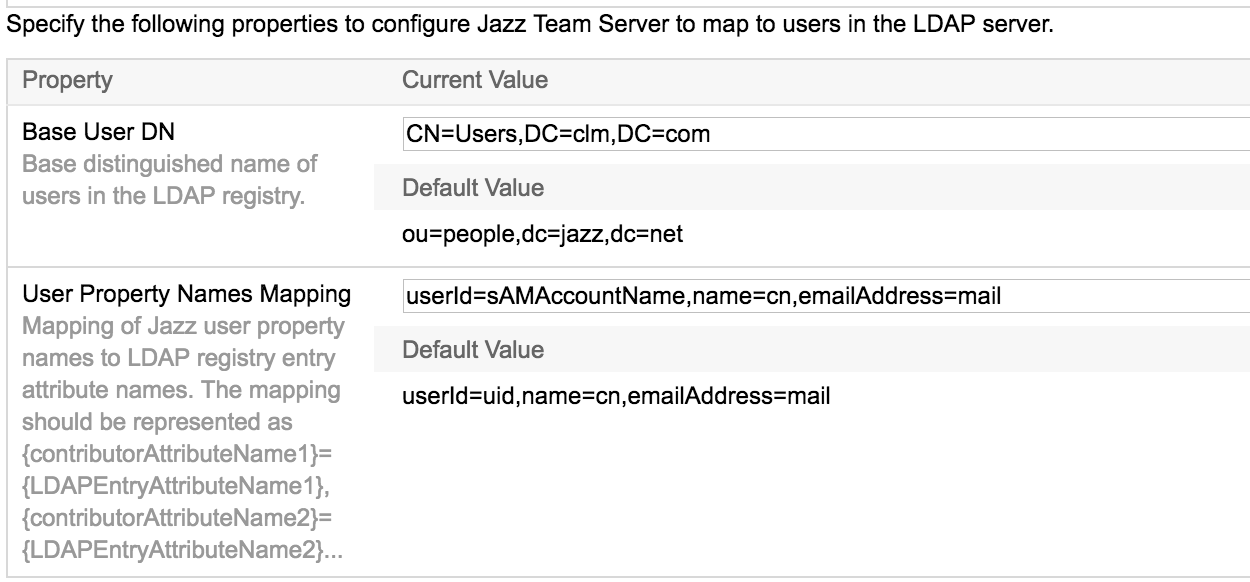
- - Group DN, Role and Property mapping
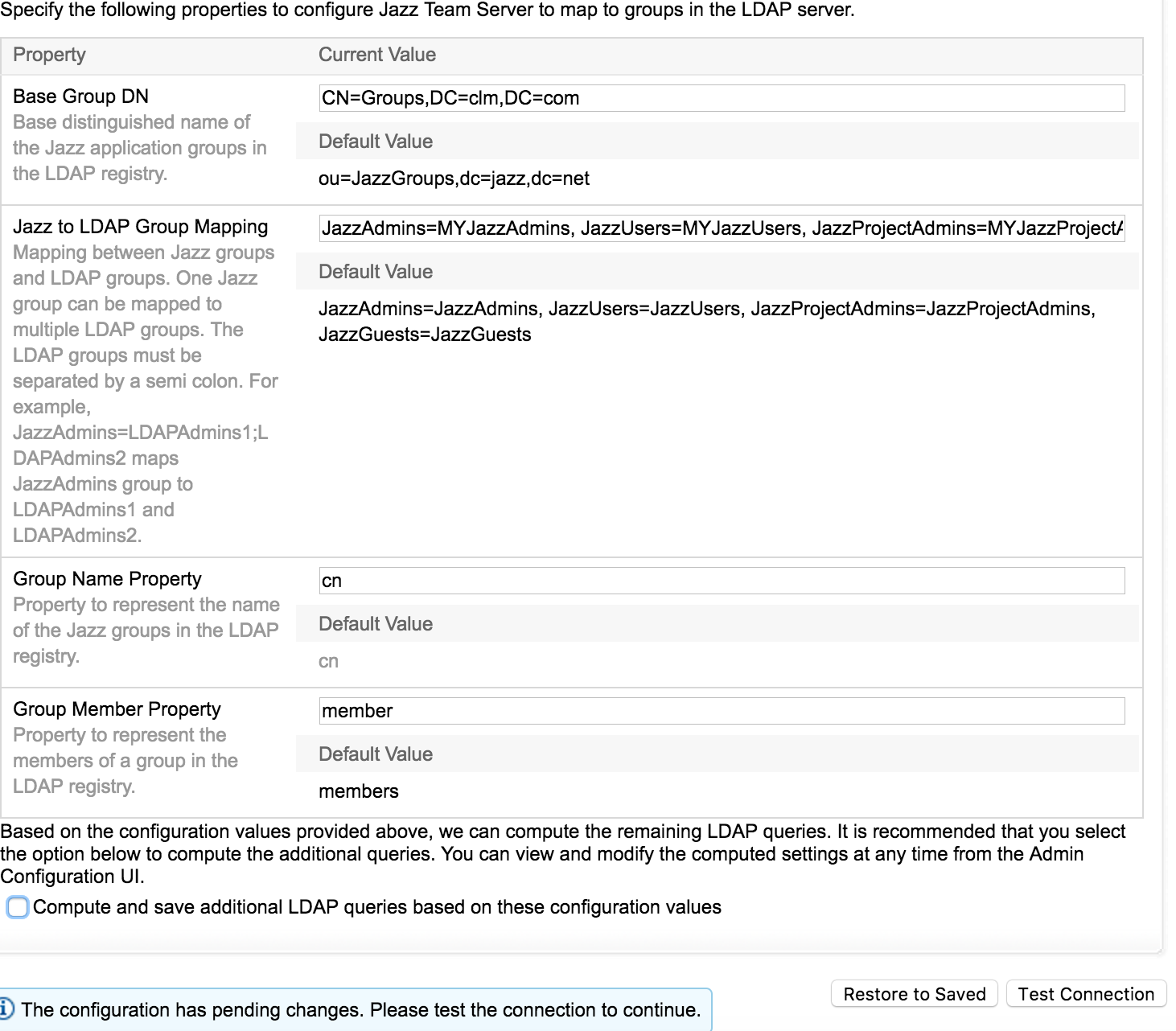
- - LDAP Server and Bind User details
- Assign a license and click Next
- A Login window would be displayed, Login as a user with JazzAdmin role assigned
- Go back to Register Applications page (Step 5) and register all the applications
- Complete the setup
ELM User group-to-role mapping
User Groups to Jazz Roles mappings (JazzAdmins, JazzUsers etc) are picked from JTS configuration when JAS is configured with LDAP. When Users accesses an ELM application URL, they are redirected to JAS for Authentication. Post successful authentication JTS performs the ldapsearch Query to fetch groups with LDAP details mentioned underJTS > Advanced Properties > com.ibm.team.repository.service.jts.internal.userregistry.ldap.LDAPUserRegistryProvider for User group to Jazz role mappings.
Note: We can only map direct LDAP groups in JTS. Special Subjects like ALL_AUTHENTICATED_USERS or NESTED_GROUPS would not work with JAS based deployments
Here is an extract from JTS logs with debug enabled, where it is mapping to the Jazz Groups configured in JTS.
DEBUG m.repository.servlet.internal.oidc.OidcAuthHandler [TID: 37404299] - Using group-to-role mapping
"{cn=MYJazzAdmins,CN=Groups,DC=clm,DC=com:[JazzAdmins],cn=MYJazzGuests,CN=Groups,DC=clm,DC=com:[JazzGuests],cn=MYJazzProjectAdmins,CN=Groups,DC=clm,DC=com:[JazzProjectAdmins],cn=MYJazzUsers,CN=Groups,DC=clm,DC=com=com:[JazzUsers]}" for 300000 ms
/jts/service/com.ibm.team.repository.service.internal.IExternalUserRegistryRestService/externalUserRegistryConfiguration]
DEBUG ce.jts.internal.userregistry.ldap.LDAPUserRegistry [TID: 7FEA9AFC] - Query to fetch group full names - ldapsearch -h ldap://ldapserver:389 -b "CN=Groups,DC=clm,DC=com" "(| (cn=MYJazzAdmins)(cn=MYJazzGuests)(cn=MYJazzProjectAdmins)(cn=MYJazzUsers))"
For new installations, during JTS/Setup select the User registry type as LDAP and configure to the same LDAP registry that is configured with JAS and enter the group mappings under the property Jazz to LDAP Group Mapping
Enable an Existing CLM setup for Jazz Security Architecture
- Complete the Jazz Authorization Server Setup, Configuration and testing as per instructions within this article
- Enable CLM applications for Jazz Security Architecture single sign-on following the instructions on our InfoCenter
Related topics: Jazz Authorization Server, Deployment web home
External links:
Contributions are governed by our Terms of Use. Please read the following disclaimer.
Dashboards and work items are no longer publicly available, so some links may be invalid. We now provide similar information through other means. Learn more here.